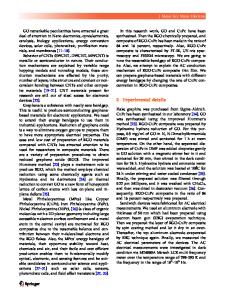Synthesis and Characterization of Copper Oxide Compounds
- PDF / 294,068 Bytes
- 10 Pages / 432 x 648 pts Page_size
- 51 Downloads / 450 Views
Synthesis and Characterization of Copper Oxide Compounds K.P. Hering, A. Polity, B. Kramm, A. Portz and B.K. Meyer I. Physics Institute, Justus-Liebig-University Giessen, Heinrich-Buff-Ring 16, 35392 Giessen, Germany ABSTRACT The p-type conducting Copper-oxide compound semiconductors (Cu2O, CuO) provide a unique possibility to tune the band gap energies from 2.1 eV to the infrared at 1.40 eV into the middle of the efficiency maximum for solar cell applications. By a pronounced non-stoichiometry the electronic properties may vary from insulating to metallic conduction. They appear to be an attractive alternative absorber material in terms of abundance, sustainability, non-toxicity of the elements, and numerous methods for thin film deposition that facilitate low cost production. The synthesis and characterization of Cu2O thin films used as p-type absorbers in heterojunction solar cells will be reported. We discuss properties of the undoped non-stoichiometric Cu2O, controlled p-type doping by nitrogen, analysis of band offsets by X-ray photoelectron spectroscopy (XPS). In addition we show proof of concept for an increase in photovoltaic conversion efficiency in AlGaN/Cu2O heterostructures due to a more favorable band alignment. INTRODUCTION AlGaAs/GaAs ternary III-V compound semiconductors revolutionized the field of semiconductor heterostructures and opened the door towards high speed low dimensional devices. The approach was to synthesize by epitaxial growth techniques well-ordered monocrystalline layers with abrupt and atomically sharp interfaces by combining two semiconductors with different band gaps, effective masses etc. while retaining the lattice matching between the two compounds as good as possible. This concept has been widely used in the last thirty years for almost all III-V and II-VI semiconductors and their ternary and quaternary alloys with a wide range of applications from optoelectronics to solar cells. A completely different and new concept can be visualized and realized in pure binary oxide compounds such as the copper oxides or tin oxides. Here at a fixed metal to oxygen ratio one stabilizes distinct different phases such as Cu2O, Cu4O3 and CuO which have unique structural (crystal symmetry from cubic, tetragonal to monoclinic), optical (band gap energies from 2.1 to 1.4 eV, direct and indirect band gaps) and electronic (mobilities, carrier concentrations, band offsets) properties. A defined non-stoichiometry exists for all stable phases, which allows tuning the defect disorder and related to it the electronic properties from insulating to metallic conduction. The copper compounds are intrinsically p-conducting oxides and bi-polar doping is still at an exploratory phase. Surface conductivity is different from bulk conductivity as is ionic conduction from electronic conduction. For many applications (gas sensors, heterojunction solar cells and thin film transistors) polycrystalline materials are used and the routes towards high ordered epitaxial growth giving bench marks for the materials’ quality
Data Loading...










